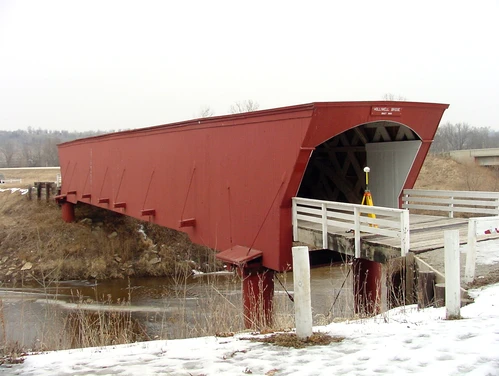- Year constructed: 1879-1880
- Bridge type: Covered Timber Town Lattice Truss
- National Register of Historic Places status: Listed
- Length: 159 feet
- Width: 14 feet
- Spans: 1
- FHWA: 233080
- Jurisdiction: Madison County
- Location: West of the current alignment of Holliwell Bridge Road over the Middle River, 2 miles southeast of Winterset, Section 4, T75N-R27W (Scott Township)
Details
In Madison County, the North, South and Middle Rivers formed the most serious impediments to overland travel, but several smaller streams required substantial bridged crossings as well. To bridge the myriad of streams, the county board of supervisors ordered numerous short-span timber pile and kingpost structures built in the 1850s and 1860s. Though inexpensive to erect, most of these spans tended to be structurally suspect and required frequent maintenance to prevent their collapse. Moreover, they were restricted to short-span crossings.
With limited funds and an abundance of crossings, the county elected to leave these earliest structures uncovered. This did not pose a serious threat to the timber pile spans, which rarely lasted long enough to suffer damage by rain and snow. But more complex and expensive timber trusses, left open to the weather, proved vulnerable to deterioration in their upper chord connections. For this reason, the county began sheathing its wooden through trusses with shingle roofs and plank siding in the late 1860s. Between 1870 and 1872, the county built several covered bridges, including the Wilkin's Ford or Imes Bridge, and the Cutler-Donahoe Bridge.
Madison County continued building covered bridges in the 1870s, culminating in 1879 with the Holliwell Bridge over the Middle River southeast of Winterset. In 1879 the existing bridge at Holliwell, a 40-foot timber structure, required replacement, and the county contracted with local carpenter H.P. Jones and G.K. Foster to build the replacement, a 110-foot, timber truss on iron cylinder piers. Like several of its predecessors, the bridge employed a Town lattice truss configuration, with a pair of timber arches superimposed over the truss, covered by a wood frame, roof and walls. Completed in 1880 for a cost of $1,180, the Holliwell Bridge has carried traffic since, with maintenance-related replacement of some of its sheathing components and approach spans as the only alterations.
Popularized in literature and a recent movie, and visited en masse by tourists during the annual covered bridge festivals, the covered bridges of Madison County are easily Iowa's most famous spans. As a group, they well represent covered bridge technology, which predominated in the state before widespread adaptation of all-metal spans in the 1870s. With its 110-foot span, the Holliwell Bridge is the longest of these bridges, and the longest remaining timber bridge in the state. It stands in well-preserved condition today.
Adapted from Fraser 1992
Areas Served
- Madison
